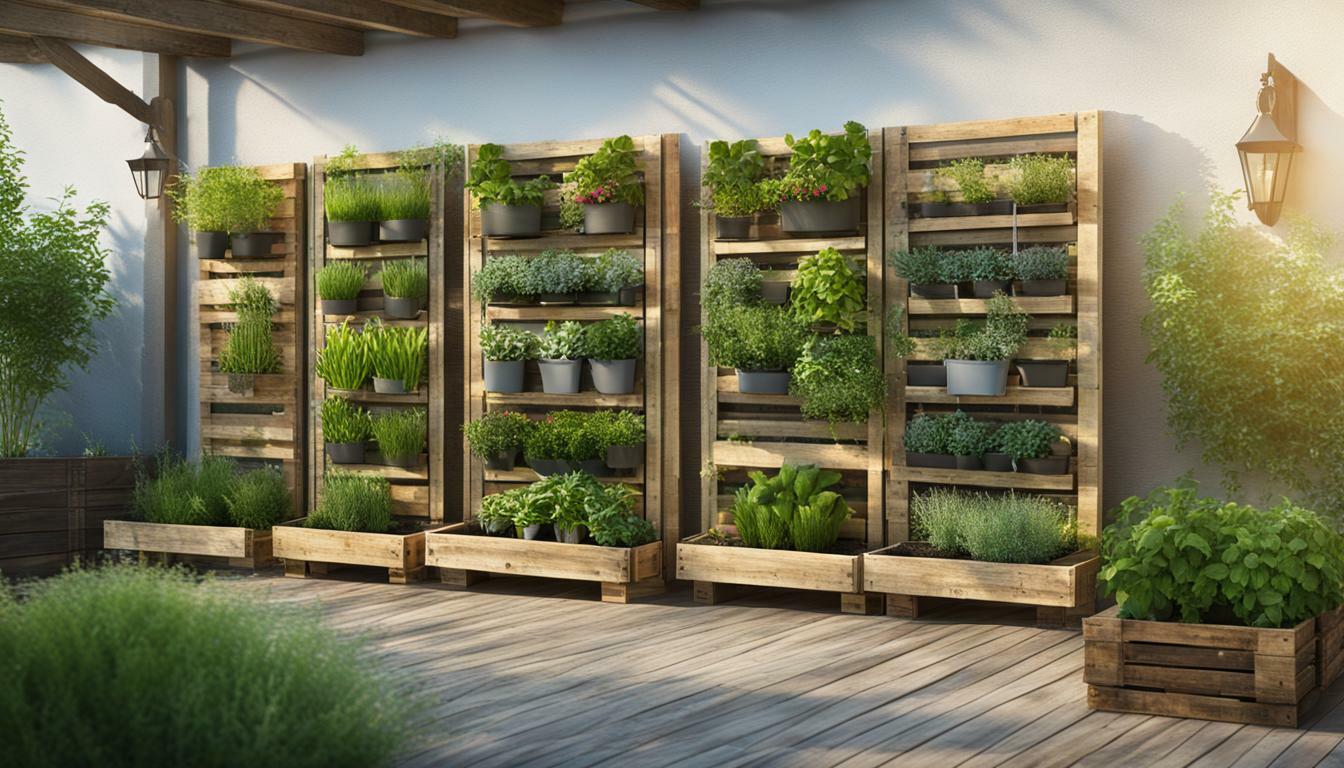Creating a beautiful and functional pallet vertical herb garden requires mastering the design. This innovative gardening solution allows you to maximize your garden space and have easy access to fresh herbs. Whether you have limited outdoor space or simply want to add a unique touch to your garden, a pallet vertical herb garden is a perfect choice.
Key Takeaways:
- Designing a pallet vertical herb garden is essential for creating a functional and aesthetically pleasing space.
- By mastering the design, you can save space and have easy access to fresh herbs.
- Choosing the right pallet and supplies, preparing the pallet, and assembling the vertical garden are important steps in the design process.
- Selecting the right herbs and properly planting them will ensure optimal growth and success.
- Maintenance and care tips, as well as troubleshooting common issues, are crucial for the longevity and health of your garden.
- Exploring design ideas and plant suggestions can help create a visually appealing and thriving vertical herb garden.
Now that you understand the importance of mastering the design of a pallet vertical herb garden, let’s delve into the benefits and explore the steps involved in creating your own. By following these guidelines, you’ll be well on your way to creating a stunning and practical addition to your garden space.
The Benefits of a Pallet Vertical Herb Garden
A pallet vertical herb garden offers numerous benefits, making it an ideal choice for those with limited space or a desire for fresh herbs at their fingertips. Whether you live in an apartment or have a small backyard, a vertical herb garden allows you to grow a variety of herbs without taking up valuable floor space. Here are some of the key benefits:
- Space-saving: With a pallet vertical herb garden, you can maximize your growing potential in a compact area. By utilizing vertical space, you can grow a larger quantity of herbs compared to traditional horizontal gardens. This is especially beneficial for those with limited outdoor space.
- Easy access to fresh herbs: Having a pallet vertical herb garden means you can have fresh herbs right at your fingertips. No more running to the grocery store or relying on dried herbs. Simply pick the herbs you need for cooking or garnishing, ensuring the highest quality and flavor in your dishes.
- Enhanced aesthetics: A pallet vertical herb garden adds a touch of beauty and greenery to any space. It can serve as a focal point or decorative feature, enhancing the overall aesthetics of your outdoor area or balcony. You can even customize the design and arrangement of the herbs to create a visually appealing display.
- Environmental benefits: Growing your own herbs in a vertical garden reduces the need for store-bought herbs, which are often packaged in plastic and transported long distances. By growing your own herbs, you can reduce your carbon footprint and contribute to a more sustainable lifestyle.
A pallet vertical herb garden is a versatile and practical solution for herb enthusiasts, offering benefits such as space-saving, easy access to fresh herbs, enhanced aesthetics, and environmental sustainability. With the right design and care, you can enjoy a bountiful herb harvest right outside your door.
Table: Comparison of Pallet Vertical Herb Garden vs. Traditional Horizontal Garden
| Aspect | Pallet Vertical Herb Garden | Traditional Horizontal Garden |
|---|---|---|
| Space utilization | Maximizes vertical space | Utilizes horizontal ground space |
| Accessibility | Easy access to herbs at eye level | Requires bending and reaching for herbs |
| Aesthetics | Adds visual appeal to any space | May require more space for traditional garden beds |
| Sustainability | Reduces reliance on store-bought herbs | Dependent on store-bought herbs and packaging |
“A vertical garden is a fantastic way to grow herbs in small spaces, and it adds a touch of greenery to any area.” – Kate Pruitt
By choosing to build a pallet vertical herb garden, you can enjoy the benefits of fresh herbs, space optimization, and a visually appealing addition to your living space. With careful planning and maintenance, your vertical garden can be a sustainable and convenient source of culinary delights for years to come.
Choosing the Right Pallet and Supplies
Before embarking on your pallet vertical herb garden project, it’s important to choose the right pallet and gather all the necessary supplies. The selection of the pallet will determine the stability and durability of your vertical garden, while the supplies will ensure proper growth and maintenance of your herbs.
“Planning on using pallets to make your space-saving vertical herb garden? Don’t forget to choose the right kind of pallet. Though the wood here doesn’t come in contact with the plants and soil, chemicals present in some pallets can still contaminate your herbs!”
To begin, select a pallet made of untreated wood or marked with “HT,” which means heat treated. This ensures that no harmful chemicals will leach into your herbs. You can often find free pallets at landscaping or home improvement stores, or even recycle centers. Choose a pallet size that suits your space, such as a recommended size of 25″ x 38″.
Aside from the pallet, you will also need a roll of landscaping fabric to create pockets for the herbs, sandpaper to smooth out rough spots on the pallet, a staple gun and staples to attach the fabric securely, and potting soil to provide a nutrient-rich environment for your herbs to thrive. It’s essential to use potting soil specifically designed for container gardening, as it provides proper drainage and moisture retention.
| Supplies Needed: |
|---|
| – Wooden pallet |
| – Roll of landscaping fabric |
| – Sandpaper |
| – Staple gun and staples |
| – Potting soil |
| – Herbs, succulents, or other plants |
Choosing the Right Pallet and Supplies
When selecting herbs for your vertical garden, opt for varieties that can tolerate dry conditions and limited space. Consider using herbs in pot sizes of 4″ or less, as they are easier to fit through the slats of the pallet. Some popular options include basil, parsley, mint, thyme, and rosemary.
Once you have gathered all the necessary supplies, you’re ready to proceed with building your pallet vertical herb garden. The next section will guide you through the process of preparing the pallet for assembly.
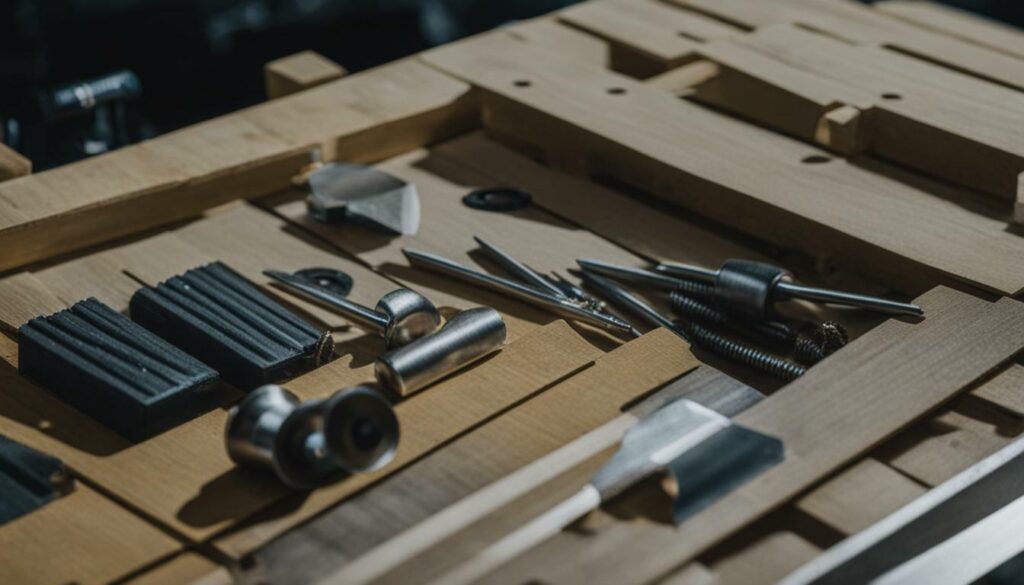
Preparing the Pallet
Properly preparing the pallet is essential for ensuring stability and longevity of your vertical herb garden. By following a few simple steps, you can create a sturdy foundation for your plants to thrive.
Start by sanding down any rough spots on the pallet using sandpaper. This will help prevent splinters and make the surface smoother for attaching the landscaping fabric. Additionally, if the back of your pallet doesn’t have much support, it’s recommended to find scrap wood that is 3 to 4 inches wide and 1/4 inch thick. Cut the scrap wood to the width of your pallet and attach it to the back for added support. Use two nails on each side to secure the supports evenly down the back of the pallet.
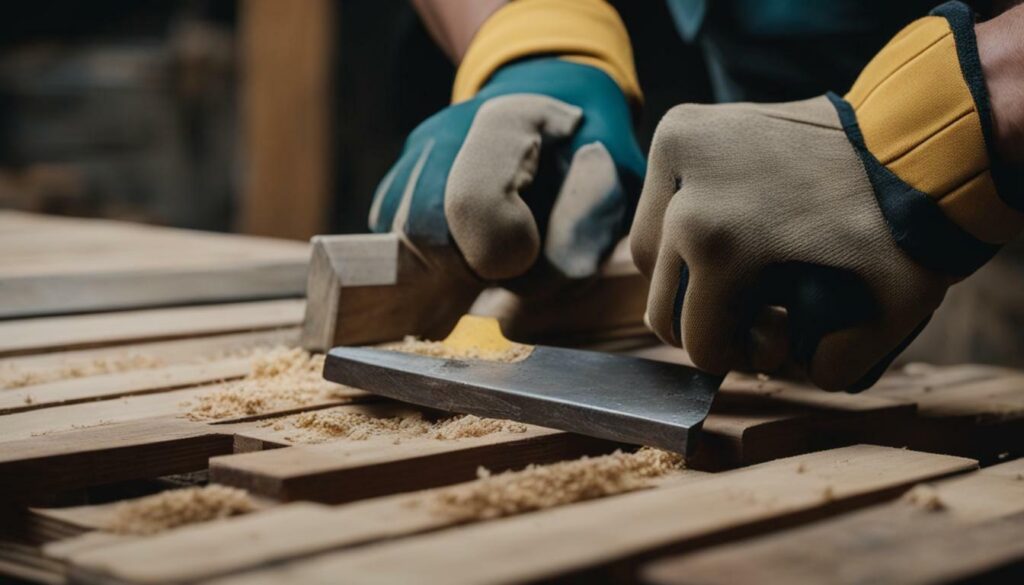
Next, it’s time to attach the landscaping fabric. Double or triple the fabric or plastic to create a strong barrier against soil leakage. Staple the fabric along the back, bottom, and sides of the pallet, being careful to fold the fabric at the corners to prevent soil from spilling out. This step is crucial for keeping the potting soil contained within the pallet while allowing water to drain properly.
Finally, lay the pallet flat and pour potting soil through the slats, pressing it down firmly. Leave enough room at the top to begin planting your herbs or succulents. As you plant, start from the bottom of the pallet and work your way up, ensuring that the soil is firmly packed in each layer. Add more soil as needed to ensure the plants are tightly packed at the end.
Once you have finished preparing the pallet, water your vertical herb garden thoroughly and let it remain horizontal for 1 to 2 weeks. This will allow the plants to establish their roots before you set the garden upright. When watering your garden, start at the top and gradually water each subsequent section less, as water will naturally seep down to the bottom-most plants. Alternatively, you can install drip irrigation for convenient watering.
By properly preparing your pallet, you are setting the stage for a successful and thriving vertical herb garden. Take the time to ensure stability and proper drainage, and you’ll be rewarded with an abundant and beautiful herb garden right at your fingertips.
Assembling the Vertical Herb Garden
Follow these step-by-step instructions to assemble your vertical herb garden, creating the perfect environment for your herbs to thrive.
1. Sand down any rough spots on your pallet using sandpaper. If the back of your pallet is open and lacks support, find scrap wood that is 3 to 4 inches wide and 1/4 inch thick, and cut it to match the width of your pallet. Attach these supports to the back of the pallet using two nails on each side to ensure stability.
2. Double or triple a roll of landscaping fabric or use plastic to line the back, bottom, and sides of the pallet. Be careful to fold in the fabric at the corners to prevent soil from spilling out.
3. Lay the pallet flat and pour potting soil through the slats, pressing it down firmly. Leave enough room to begin planting your herbs or succulents.
4. Start planting at the bottom of the pallet and work your way up, ensuring that the soil is firmly packed in each layer as you go. If needed, add more soil to tightly pack the plants at the end.
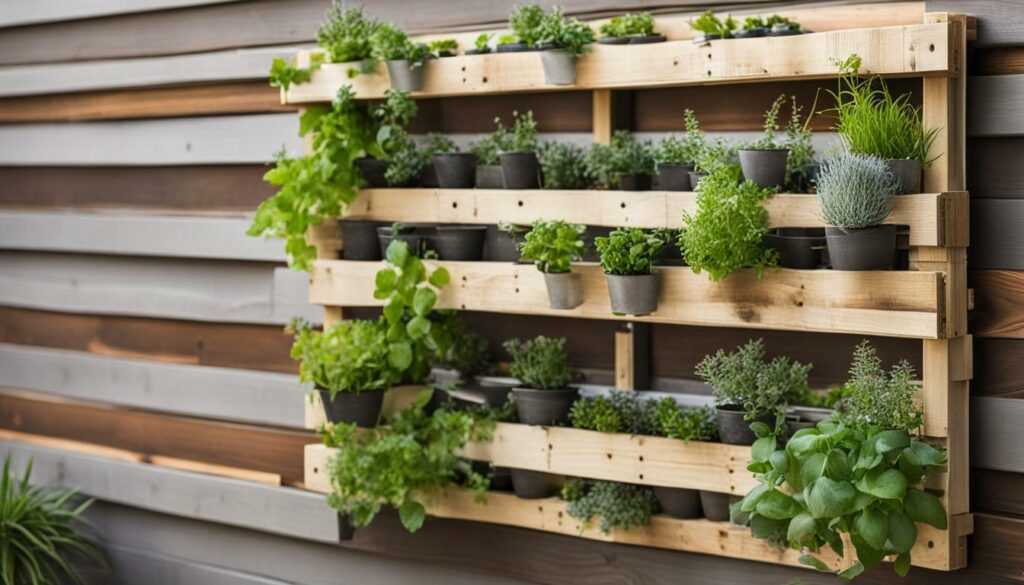
5. After planting, water your vertical garden thoroughly and allow it to remain horizontal for 1 to 2 weeks to allow the plants to take root. After this initial period, you can set it upright.
Following these steps will help you create a sturdy and functional vertical herb garden that will provide you with easy access to fresh herbs while saving space in your garden. Enjoy the beauty and convenience of your new herb garden!
| Materials: | Tools: |
|---|---|
| Used Pallets | Kreg Jig |
| 1×4 Boards | Drill |
| Long Screws | Clamps |
| Wood Glue | Level |
| Paint of your choice | Paint Brush |
| Vinyl or Stencil for labeling the herbs | Pallet Breaker |
- Revamp the old pallets by replacing bad boards with new ones and attach two wooden legs on the sides below to make them stand.
- Consider using a pallet breaker to speed up the process of assembling your vertical herb garden.
- Choose a high-quality paint to coat your pallet for a long-lasting finish.
- Add labels to your vertical herb garden to avoid confusion about the herbs you have planted.
With these tips and instructions, you’ll be able to assemble your own vertical herb garden and start enjoying the benefits of having fresh herbs right at your fingertips.
Choosing and Planting Herbs
Carefully choose the herbs that will thrive in your vertical garden and follow these planting tips for success.
When selecting herbs for your pallet vertical herb garden, consider the growing conditions and the space available. Some herbs are better suited for vertical gardens, while others may require more space to spread out. Here are a few herbs that do well in vertical gardens:
- Basil: This fragrant herb thrives in sunny locations and adds a delicious flavor to salads and pasta dishes.
- Thyme: With its compact growth habit, thyme is an excellent choice for vertical gardens. It enjoys full sun and well-drained soil.
- Rosemary: This perennial herb is known for its distinct aroma and flavor. It prefers a sunny spot and well-drained soil.
- Mint: Mint is a fast-growing herb that adds a refreshing taste to beverages and desserts. However, it can be invasive, so consider planting it in a separate container within your vertical garden.
Once you’ve chosen your herbs, it’s time to plant them in your vertical garden. Follow these steps for successful planting:
- Prepare the soil by adding organic matter and ensuring it is well-drained.
- Place the herbs in their desired locations within the vertical garden, considering their size and growth habits.
- Make sure the herbs are planted at the appropriate depth and spacing to allow for root growth.
- Water the herbs thoroughly after planting, and continue to water them regularly to keep the soil evenly moist.
Remember to monitor your herbs for signs of pests or diseases, and take appropriate action to keep your plants healthy. With proper care and attention, your vertical herb garden will provide you with a bountiful harvest of fresh herbs to enhance your culinary creations.
Planting Tips:
Here are some additional planting tips to help you get the most out of your vertical herb garden:
Choose herbs that have similar water and sunlight needs to simplify maintenance.
Consider planting trailing or cascading herbs near the bottom of the vertical garden to create a visually appealing display.
Rotate your herbs periodically to ensure even growth and prevent overcrowding.
Table of Herbs and Growing Requirements:
| Herb | Sunlight | Watering | Spacing |
|---|---|---|---|
| Basil | Full sun | Regular watering | 12-18 inches apart |
| Thyme | Full sun | Low water needs | 6-12 inches apart |
| Rosemary | Full sun | Low water needs | 12-24 inches apart |
| Mint | Partial shade to full sun | Regular watering | 12-24 inches apart |
By carefully choosing and planting herbs in your vertical garden, you can enjoy a thriving and productive herb garden even with limited space. Experiment with different herb combinations to create a diverse and flavorful garden that will enhance your culinary adventures.
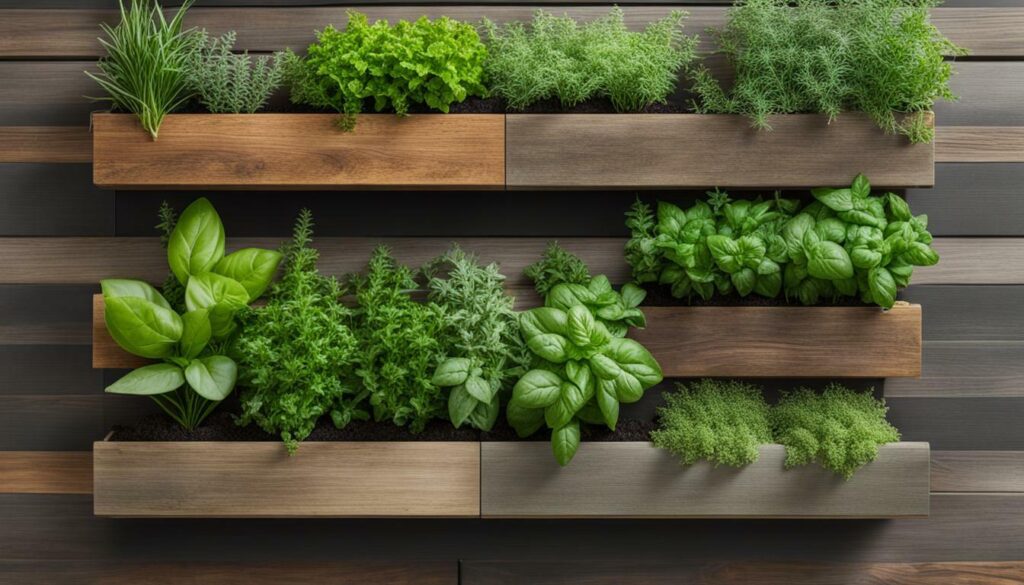
Maintenance and Care Tips
Regular maintenance and proper care will help your vertical herb garden flourish year after year. By following these tips, you can ensure that your herbs thrive and provide you with fresh, aromatic flavors for your culinary creations.
Watering
One of the most crucial aspects of maintaining a healthy vertical herb garden is proper watering. While herbs generally prefer well-drained soil, it’s important to keep them adequately hydrated.
When watering your vertical garden, start at the top and water each subsequent section a little less, as the water will naturally seep through to the bottom-most plants. Alternatively, you can install a drip irrigation system for more precise and efficient watering.
Pruning
Regular pruning is essential for promoting healthy growth and preventing overcrowding in your vertical herb garden. Trim back any yellowing or dead leaves to maintain the overall vitality of your plants.
Additionally, harvesting your herbs frequently will encourage new growth and ensure that your plants remain productive. Be sure to use a sharp pair of scissors or pruning shears to avoid damaging the plants.
Fertilizing
Providing adequate nutrients is crucial for the long-term health of your vertical herb garden. Consider using organic fertilizers, such as compost or slow-release granular fertilizers, to nourish your plants.
Follow the manufacturer’s instructions for application rates and frequency, as over-fertilizing can lead to excessive growth or nutrient imbalances. Remember to choose fertilizers that are specifically formulated for herbs to ensure optimal results.
Pest Control
Keeping pests at bay is essential for maintaining the health of your vertical herb garden. Inspect your plants regularly for signs of pests, such as aphids or mites.
If you spot any pests, take immediate action to prevent an infestation. Use organic pest control methods, such as insecticidal soaps or natural predators, to eliminate pests without harming your herbs or the environment.
Table of Maintenance and Care Tips:
| Tip | Description |
|---|---|
| Watering | Start from the top and water each subsequent section a little less. Consider installing a drip irrigation system. |
| Pruning | Regularly trim back yellowing or dead leaves and harvest herbs frequently to encourage new growth. |
| Fertilizing | Use organic fertilizers formulated for herbs according to the manufacturer’s instructions. |
| Pest Control | Inspect plants regularly for pests and use organic pest control methods to eliminate infestations. |
By following these maintenance and care tips, you can ensure the health and productivity of your vertical herb garden. With proper attention, your herbs will flourish, providing you with a fresh and convenient source of culinary inspiration.
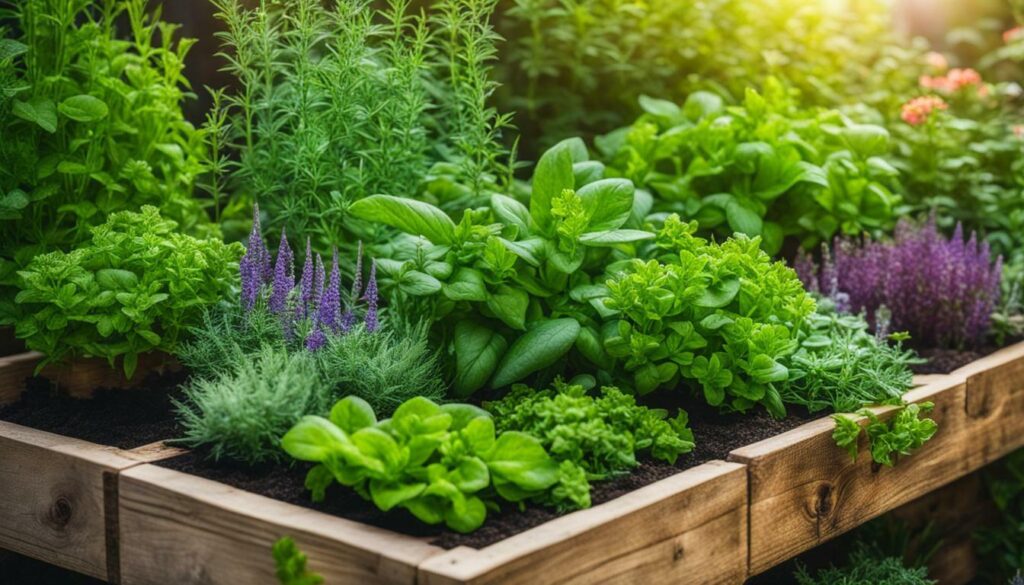
Design Ideas and Plant Suggestions
Get inspired by these design ideas and discover the best herbs to plant in your pallet vertical herb garden. With a vertical herb garden, you can create a stunning and functional display of herbs, while maximizing limited space. Whether you have a small balcony or a spacious backyard, a pallet vertical herb garden can be customized to suit your design preferences and herb choices.
One design idea is to arrange the herbs in a rainbow pattern, with different colored herbs creating a vibrant and eye-catching display. You can use herbs like purple basil, golden oregano, and variegated sage to create a visually appealing rainbow effect. Another option is to create a vertical herb garden with different levels and tiers, using the pallets to create a cascading effect. This not only adds interest to the design but also allows for easy access to each herb.
| Herb | Best Growing Conditions |
|---|---|
| Basil | Sun, well-drained soil |
| Rosemary | Sun, well-drained soil |
| Mint | Partial shade, moist soil |
| Thyme | Sun to part shade, well-drained soil |
When selecting the herbs for your vertical garden, consider their growth habits and compatibility with each other. Some herbs, like mint, can be aggressive and take over the space, so it’s best to plant them in a separate compartment or use a barrier to contain their growth. On the other hand, herbs like basil and rosemary complement each other well and can be planted together.
Maintaining your vertical herb garden is essential for its longevity and health. Regular watering, pruning, and fertilizing are necessary to ensure that the herbs thrive. Additionally, be mindful of the sunlight requirements of each herb and position your vertical garden in a location that receives the appropriate amount of sun.
Quote:
“A vertical herb garden is not only practical but also adds a touch of beauty to any space. With the right design and careful selection of herbs, you can create a stunning focal point that serves both culinary and aesthetic purposes.” – Garden Expert
Troubleshooting Common Issues
Don’t let common issues discourage you from enjoying a flourishing pallet vertical herb garden – learn how to effectively troubleshoot and overcome them. While creating and maintaining a pallet vertical herb garden may seem straightforward, it’s not uncommon to encounter a few challenges along the way. However, with the right knowledge and techniques, you can easily overcome these issues and continue to enjoy the benefits of your vertical garden.
Common Issue 1: Poor Drainage
One common issue that gardeners may face with a pallet vertical herb garden is poor drainage. If the soil retains too much water, it can lead to root rot and other moisture-related problems. To overcome this issue, ensure that your pallet has proper drainage holes or gaps between slats to allow excess water to flow out. Additionally, consider adding a layer of gravel or small stones at the bottom of the pallet before adding soil to improve drainage.
Common Issue 2: Insufficient Sunlight
Another common issue is insufficient sunlight, especially if your vertical garden is placed in a shaded area or blocked by other structures. Herbs generally require at least 6 hours of direct sunlight per day to thrive. If you face this issue, consider relocating your pallet vertical herb garden to a sunnier spot or using grow lights to supplement the available sunlight.
Common Issue 3: Pests and Disease
Pests and diseases can also affect the health of your herbs in a vertical garden. Common pests include aphids, snails, and caterpillars, while diseases like powdery mildew and fungal infections can also occur. To prevent and manage these issues, regularly inspect your plants for signs of pests or diseases, and take appropriate measures such as using organic pest control methods or applying fungicides when necessary. Proper plant spacing can also help minimize the risk of disease spread.
By being aware of these common issues and taking proactive steps to address them, you can ensure the success of your pallet vertical herb garden. Remember to monitor your plants regularly, provide proper care and maintenance, and seek advice from local gardening resources or experts if needed. With a little patience and troubleshooting, you’ll be able to enjoy a thriving and bountiful herb garden all year round.
| Common Issues | Solutions |
|---|---|
| Poor Drainage | Ensure proper drainage holes or gaps between slats, consider adding gravel or stones at the bottom for improved drainage. |
| Insufficient Sunlight | Relocate to a sunnier spot or use grow lights for supplemental lighting. |
| Pests and Disease | Regularly inspect plants for pests and diseases, use organic pest control methods, apply fungicides if necessary, and practice proper plant spacing. |
“A successful garden requires patience, attention, and the willingness to troubleshoot and adapt.”
Conclusion
By mastering the design of a pallet vertical herb garden, you can create a stunning and functional space to enjoy fresh herbs year-round. The benefits of a pallet vertical herb garden are numerous. Not only does it save space, but it also provides easy access to a wide variety of herbs for cooking, medicinal purposes, or simply for their aromatic qualities.
When it comes to choosing the right pallet and supplies for your vertical herb garden, be sure to select a pallet made of untreated wood or one that is marked with “HT” for heat treated. This will ensure that no harmful chemicals leach into your herbs. Additionally, gather the necessary supplies such as landscaping fabric, staple gun, and potting soil to create a sturdy and well-drained environment for your herbs to thrive.
Preparing the pallet is an essential step in the process. Take the time to sand down any rough spots and add support to ensure stability. Assembling the vertical herb garden involves attaching landscaping fabric and filling it with potting soil. Remember to firmly pack the soil and leave enough room for planting your chosen herbs.
Choosing and planting the right herbs is crucial for the success of your vertical garden. Consider the growing conditions and choose herbs that thrive in vertical setups. Take care to plant them properly for optimal growth and ensure that the soil is consistently moist but not waterlogged. Regular maintenance and care, such as watering, pruning, and fertilizing, will help keep your pallet vertical herb garden healthy and vibrant.
Get creative with the design of your vertical herb garden. Experiment with different arrangements and combinations of herbs to create a visually appealing display. Consider using labels to identify your herbs and add a personal touch to your garden. Troubleshooting common issues, such as pests or diseases, is also important to address before they can negatively impact your herbs.
In conclusion, mastering the design of a pallet vertical herb garden allows you to create a functional and visually appealing space to grow fresh herbs. With careful planning, proper care, and a touch of creativity, you can enjoy the many benefits of having your own vertical herb garden, from space-saving to easy access to a wide variety of herbs. Start your own pallet vertical herb garden today and elevate your gardening experience.
Can the Design Principles for a Vertical Herb Garden be Applied to a Vertical Vegetable Garden Using Pallets?
Yes, the design principles for a vertical herb garden can definitely be applied to a vertical pallet vegetable garden. Both types of gardens require careful consideration of spacing, drainage, and sunlight exposure. By utilizing pallets, you can create an efficient and compact growing space for a variety of vegetables.
FAQ
Q: How difficult is it to build a pallet vertical herb garden?
A: Building a pallet vertical herb garden is rated as a difficulty level 3 out of 10. It is a relatively easy DIY project that can be accomplished with basic tools and materials.
Q: How much does it cost to build a pallet vertical herb garden?
A: The estimated cost of building a pallet vertical herb garden ranges from $15 to $35, depending on the plants chosen and the supplies needed.
Q: How much time does it take to build a pallet vertical herb garden?
A: The total time required to build a pallet vertical herb garden is approximately 2.5 hours.
Q: What supplies are needed to build a pallet vertical herb garden?
A: The supplies needed include a wooden pallet, roll of landscaping paper, sandpaper, staple gun and staples, hammer and nails, potting soil, and herbs or succulents that can tolerate dry conditions.
Q: How do you assemble a pallet vertical herb garden?
A: The assembly process involves sanding down rough spots on the pallet, adding support to the back of the pallet if necessary, stapling landscaping fabric along the back, bottom, and sides of the pallet, pouring potting soil through the slats, and planting the herbs or succulents.
Q: What type of herbs can be planted in a pallet vertical herb garden?
A: Herbs or succulents that can tolerate dry conditions and have pot sizes of 4″ or less are recommended for a pallet vertical herb garden.
Q: How should a pallet vertical herb garden be watered?
A: When watering a pallet vertical herb garden, it is best to start at the top and water each subsequent section a little less. Alternatively, a drip irrigation system can be installed.
Q: How long should a pallet vertical herb garden remain horizontal before setting it upright?
A: After watering, it is recommended to leave the pallet vertical herb garden horizontal for 1 to 2 weeks to allow the plants to take root before setting it upright.
Q: What are some design ideas and plant suggestions for a pallet vertical herb garden?
A: Design ideas for arranging the herbs in a pallet vertical herb garden can be personalized based on preference. Some suggested plants for a vertical herb garden include basil, thyme, oregano, rosemary, and mint.
Q: What are some common issues that may arise with a pallet vertical herb garden?
A: Common issues with a pallet vertical herb garden can include lack of proper drainage, overwatering, and pests. These issues can be addressed by ensuring proper installation and maintenance.

